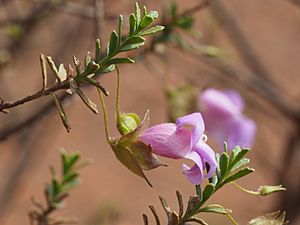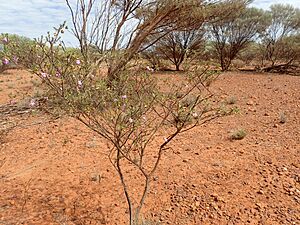Eremophila punctata facts for kids
Quick facts for kids Eremophila punctata |
|
|---|---|
 |
|
| Eremophila punctata leaves and flowers | |
| Scientific classification | |
| Genus: |
Eremophila (plant)
|
| Species: |
punctata
|
Eremophila punctata is a beautiful flowering plant that belongs to the figwort family. You can only find it growing naturally in Western Australia. This plant is an upright shrub with young branches and leaves that feel sticky because they are covered in a natural resin. Its small leaves often have a few blunt teeth near their ends, and its flowers are usually a lovely lilac color. It's a unique and common plant in its native area.
Contents
What Does Eremophila punctata Look Like?
Eremophila punctata is an upright shrub that usually grows between 0.5 and 2.2 meters (about 1.5 to 7 feet) tall. Its young branches and leaves are covered with a sticky substance called resin. This resin often dries into a whitish film. The branches also have many tiny glandular hairs, which are like small bumps that produce the sticky resin.
The leaves of this plant are arranged one after another along the stem. They are often grouped together near the ends of the branches. The leaves are narrow and shaped like a spear, usually 9 to 16 mm (about 0.35 to 0.6 inches) long and 1.5 to 3.5 mm (about 0.06 to 0.14 inches) wide. They have many small, raised glands and a few blunt teeth or rounded parts near their tips.
The flowers usually grow one by one where a leaf meets the stem. They sit on hairy stalks that are typically 3 to 20 mm (about 0.1 to 0.8 inches) long. Each flower has 5 green to reddish-purple or purplish-brown, hairy sepals, which are like small leaves that protect the bud. These sepals are mostly 10 to 16 mm (about 0.4 to 0.6 inches) long.
The petals of the flower are 20 to 30 mm (about 0.8 to 1.2 inches) long. They are joined together at their bottom to form a tube. This petal tube is usually pale to deep lilac or deep purple. Sometimes it can be mauve, purple violet, or white on the outside. The inside of the tube is white and has purple spots. The outside of the petal parts and most of the tube are hairy. However, the inside of the petal parts is smooth, and the inside of the tube is very fuzzy. The flower has 4 stamens, which are the parts that produce pollen. These stamens are completely hidden inside the petal tube.

Life Cycle and Reproduction
Eremophila punctata flowers from June to October. After the flowers bloom, they produce fruits. These fruits are dry, woody, and oval-shaped, about 5.5 to 6.5 mm (about 0.2 to 0.25 inches) long. They have a hairy, papery covering.
How Eremophila punctata Got Its Name
This plant was first officially described by a scientist named Robert Chinnock in 1980. The description was published in a scientific journal called Journal of the Adelaide Botanic Garden. The second part of its scientific name, punctata, comes from a Latin word meaning "punctuated" or "pointed." This refers to the small glands that look like dots on the leaves of the plant.
Where Eremophila punctata Grows
Eremophila punctata is found across a wide area in Western Australia. It grows between places like Lake Rason and Newman. You can find it in sandy or stony soils, often in rocky areas, within different natural regions such as the Gascoyne, Gibson Desert, Great Victoria Desert, Little Sandy Desert, and Murchison.
Conservation Status
The Western Australian Government Department of Parks and Wildlife has classified Eremophila punctata as "not threatened." This means that the plant is not currently at risk of disappearing.
Growing Eremophila punctata in Gardens
This eremophila plant is popular in gardens because it produces many pale pink to deep lilac flowers for a long time. These flowers also attract butterflies and other insects, which helps with pollination. You can grow new plants from cuttings, which are small pieces of the plant. However, it's often easier to grow them by grafting them onto Myoporum rootstock, which means joining a piece of Eremophila punctata onto the roots of a Myoporum plant.
Eremophila punctata prefers soils that drain water well. It can grow in full sunlight or in partial shade. This plant is also very good at handling dry conditions, meaning it doesn't need a lot of water. However, it is sensitive to frost. Strong frost can even kill the plant.

